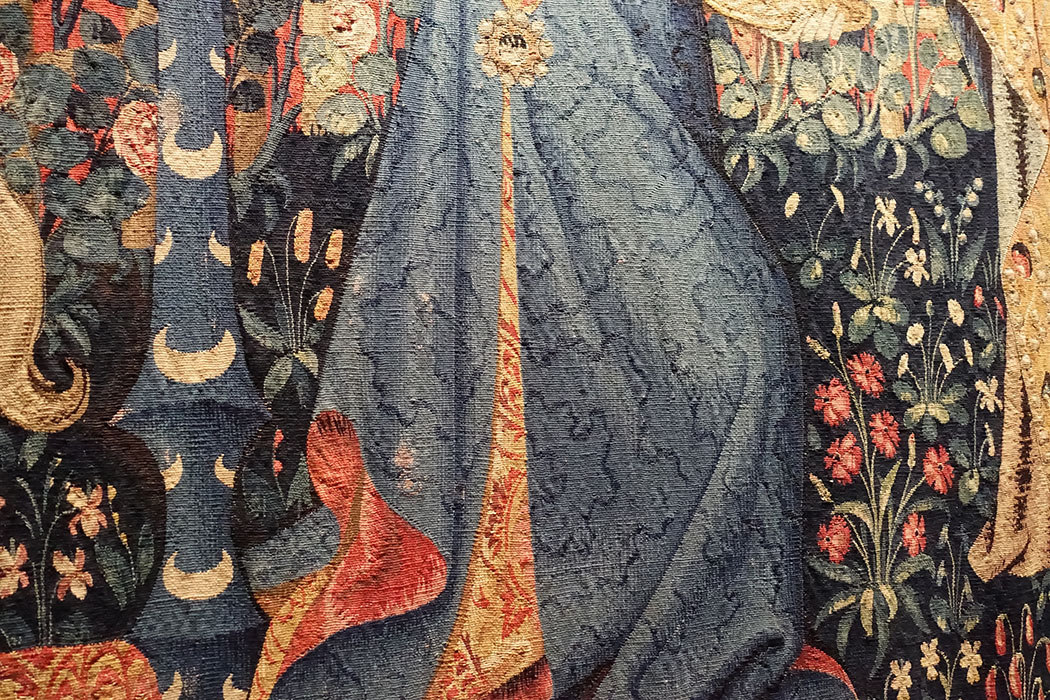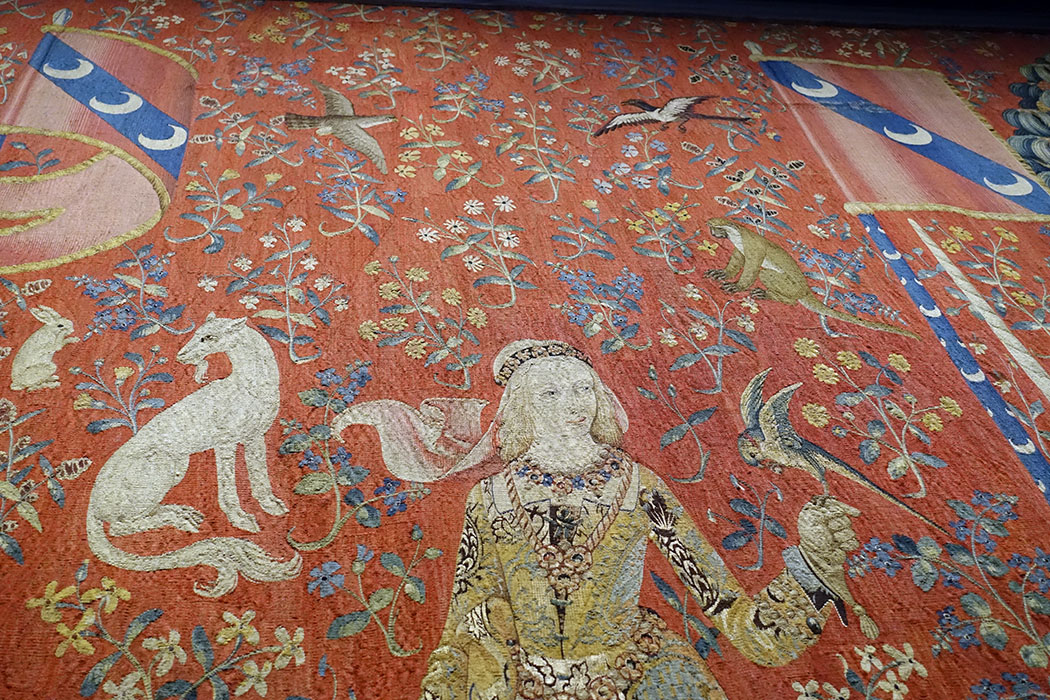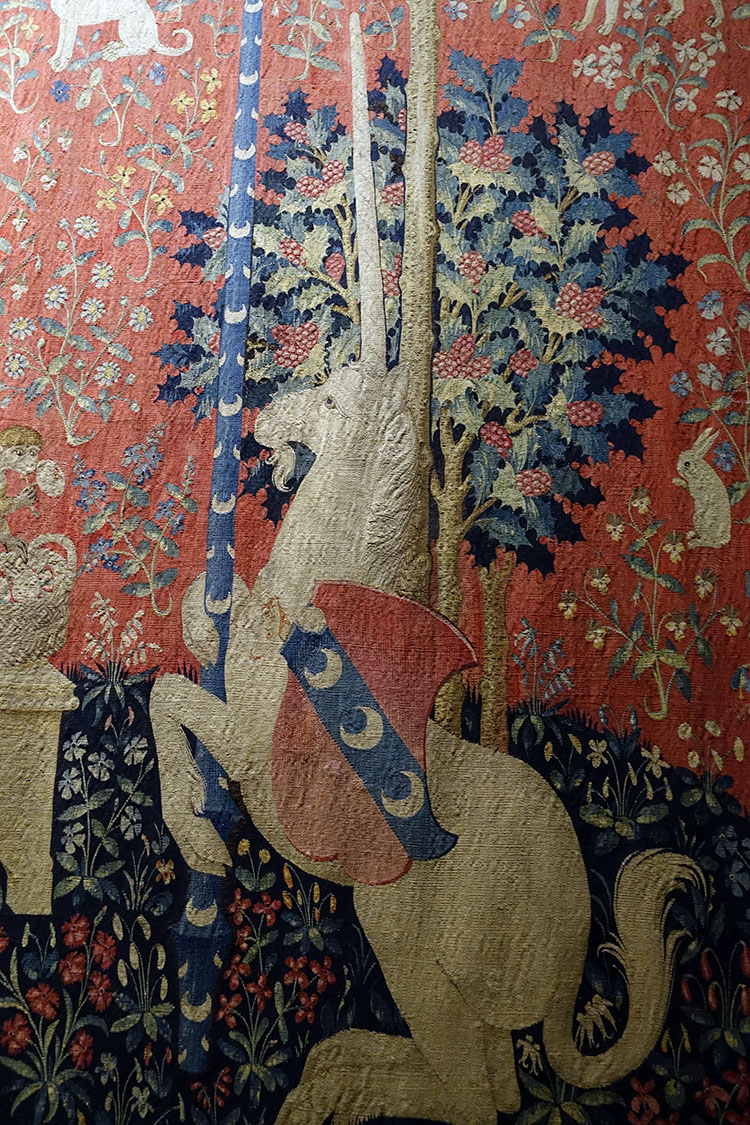I was lucky enough to be able to join a tapestry tour of France with Cresside Collette in May. Fittingly, the first place we visited was the Musée de Moyen Age* in Paris to see The Lady and the Unicorn tapestries (La Dame a la licorne). Unfortunately most of the museum was closed for renovations and I was disappointed we couldn’t see the Life of St. Stephen tapestry. But I was grateful that the Unicorn tapestries were on display and suspect they are a major draw for this museum. They are displayed in a one large room. Each of the six tapestries is between about 3.5 and 4.5 meters square.
The Lady and the Unicorn tapestries at the Musée de Moyen Age in Paris.
A brief history of the tapestries
There are six known tapestries in this series. They were probably woven around 1500 and were discovered in the mid-19th century in the château de Boussac in central France. They were in poor condition and the Musée de Moyen Age (the Cluny) purchased them in 1882. The tapestries were commissioned by the Le Viste family whose coat of arms is seen in each of the tapestries. A set of tapestries as fine as these would have cost a literal fortune and only someone with great wealth could have afforded them.
The tapestries were probably woven in Flanders (now Belgium) around 1500 are one of the best examples of tapestry surviving from the Middle Ages. There are many stories, theories, and much writing has been done about the meaning of these tapestries.
Cresside Collette, the leader of our band of tapestry enthusiasts, has seen these tapestries many times and wrote an article about them when they visited New South Wales, Australia entitled Intimate Encounters with the Unicorn.
“Personally, I have been extremely lucky to have viewed them now ten times since 1979, and felt their magic on every occasion. What is it that creates this feeling of wonder, of connection, of being ’lost’ in the beauty of their decorative expanses, the vibrancy of their colour, the exquisite detail of their execution? There is something quite enigmatic that seizes you, drawing you into their mystery. It is, most assuredly, the mysteries that surround them, the fact that the theories about their history and meaning are fluid and can’t quite be pinned down that hold you captive, in thrall to their beauty. They invite a personal communion, an interpretation that is singular to the beholder. Generating that experience of intimacy is essential to their power.”
I couldn’t agree more with Cresside’s assessment of their wonder and feeling of connection. I couldn’t put my finger on why I felt this way about them when I saw them. I did not expect to be wowed by these tapestries. I know they’re famous, but I guess I just thought I’d seen enough photos of them that my experience would parallel looking at them in books. I was wrong. Visiting these tapestries in person was a marvelous experience. They are full of mystery and charm that just isn’t expressed in photographs.
The mystery of the ladies
The subject matter of these tapestries has been much debated. There is some consensus that five of them are based on the five senses with the sixth, Mon Seul Desir being an elaborate puzzle which doesn’t quite fit into that five-senses paradigm. Elizabeth Taburet-Dalahaye suggests in THIS talk as well as her book The Lady and the Unicorn, that the sixth tapestry might indeed represent a sixth sense of the heart. (That book link is to the French version of the book. There is an English version but I can’t find it online right now. I bought a copy at the museum.) I recommend watching Dr. Taburet-Dalahaye’s talk which she gave at the Australian Tapestry Workshop I believe in 2016. She not only talks about the tapestries in general, she talks about the restoration that was completed in 2012 and also the ongoing restoration of the Musée de Moyen Age (which was why we couldn’t see the St. Stephen tapestries, though the new entrance is open and quite lovely).
If you Google around a little, you’ll find many images of these tapestries. Here are some photos I took.
Taste
Hearing
Sight
Touch
Smell
Mon Seul Desir
Is she putting the jewels into the casket or taking them out?
The Lady and the Unicorn, Mon Seul Desir, detail
“There are six tapestries; come, let us pass slowly in front of them. But first of all take a step back and look at them, all together. Are they not tranquil? There is little variety in them. See that blue, oval island in all of them, floating over the soft red background, which is filled with flowers and inhabited by small animals busy with their own activities. There only, in the last panel, the island rises a little, as if it had become lighter. There is always a figure, a woman, wearing different attires, but it is always the same lady. Sometimes, there is beside her a smaller figure, a maidservant, and there are always heraldic creatures: large ones, on the island, which are part of the action. To the left, a lion, and to the right, in light hues, the unicorn; they carry the same banner high above them: three silver moons rising on a blue band on a red field.”
I could have gone back many times to study these tapestries more closely. The details were so wonderful. I found the animals delightful. Each tapestry has a lion and a unicorn flanking the lady. Some of the tapestries also include a female companion to the lady. Below are some detail photographs in a gallery. It was the weaver in me that took so many details. These tapestries were woven sideways and I had difficulty figuring out how some of the techniques were achieved, especially the texture of the hair in the animals. The images are not all pristine. The room was very dark and I didn’t have a tripod. And of course only the bottom parts of the tapestries were directly in front of me. Click on the images to enlarge.
Millefleur background (“thousand flowers”)
The flowers, birds, and small animals that fill the background of the tapestries are referred to as millefleurs or thousand flowers and they evoke the natural surroundings of the scenes. Tapestry cartoons were often owned by people and certain models or figures might be used in multiple compositions. This is true of the millefleur backgrounds also. The designer of the tapestry probably didn’t specify the flowers and little animals that fill the background of these tapestries. More likely the weaving studio filled them in. The wildflowers in these tapestries represented about forty species and were common flowers in the Middle Ages. I found this quote from Taburet-Delahaya^ interesting:
“Several aspects characteristic of the development of this art in the late 15th century are to be found in The Lady and the Unicorn tapestry. The grounds strewn with flowering plants associate this hanging with a series of pieces executed in the second half of the 15th century known, for this very reason, as millefleurs. The colour of the ground, originally red but faded over the years, and the addition, on the millefleur ground, of a grassy “terrace”, also scattered with various flowers but this time in the form of flowerbeds, are, however, more original characteristics. This type of ground marks the high point of a tradition of mural decors and a fashion for a naturalistic depiction of vegetation that had developed during the Gothic period. It also shows a lack of interest in the representation of space that may appear surprising for this period. Above all, it reflects a desire to rationalize and accelerate the production of the tapestry.”
I will definitely be returning to this idea of depiction of space in future posts. One of the most interesting things to think about in all the tapestries we saw in France was how the picture plane was treated. Was there depth created? Was the plane flat? When was there depth and when were objects not in perspective?
Restoration
As you can imagine when looking at fiber pieces created around 1500, there has been much need for care and restoration over the last 500+ years. When the Musée de Cluny acquired them, they were in serious disrepair. The first restoration was done in 1882 in which they just filled in holes. The second restoration followed in 1882-1883 where repairs to some of the millefleur grounds were done. In 1889-1892, a master tapestry maker at the Gobelins restored the lower parts. This is the recognizable parts discussed below. In 1941-1944, another restoration was done. Since then the tapestries have been maintained and in 2012 they were washed. Interestingly, the museum had them hung in a circular room on curved walls and this allowed lots of dust to accumulate on them due to the way the air moved in the room. The museum has since built a square room for the tapestries. The tapestries are now held on slightly inclined walls to help support their weight.^
Dyes used
The dyes used were natural of course. Synthetic dyes did not exist in 1500. I had several interesting conversations with my fellow observers about the dyes. Cochineal? Nope, couldn’t have been because they didn’t have those little red bugs in Europe then. Madder? Perhaps—seems the most likely. The blue is certainly woad or indigo. Later study did tell us that the red is madder and the blue indigo. The greens and yellows have mostly faded to brown leaving us with the feeling that the tapestry is all blue and red. I am sure this was not true and undoubtedly if we saw the works as they looked freshly off the loom, they would have been stunningly vibrant. The fading was due to the yellow dyes not being stable. Some of the green is left in the foliage, but it has turned bluish without its yellow.
The tapestries are woven in wool and silk. The bottom of each of the tapestries had rotted away at some point and were re-woven just after they came to the Cluny (1885-1895). This was abundantly clear as the bottom portion was dyed with synthetic dyes which have since faded while the reds of the original tapestry have remained more vibrant (in the late 1800s—synthetic dyes are much better today) . The tapestries were stored poorly in the mid-1800s and the ends of all of them got damp and were chewed by rats.
In the 2012 restoration, natural dyes were used to match the original wools.
The image below is a detail from the bottom left corner of Taste. You can clearly see where the restoration was done with synthetic dyed wool.
The Lady and the Unicorn, Taste, 1800s restoration detail
Popularity
This cycle of tapestries is extremely popular, as tapestries go. When I started digging, I found that these tapestries have captured the imagination of many people over the centuries and there has been a lot written about them. The cycle traveled to New South Wales in 2018 which is where Cresside Collette last viewed them before our trip and THIS article talks more about the symbolism of the works.
It is interesting to note that when the tapestries were flown to Australia (only one of three times they have left the Cluny since 1882), they each flew on a separate plane. So precious are they that they didn’t want to risk the whole cycle being destroyed.
Further reading could take you HERE or to this beautiful video of poets responding to the tapestries. THIS video talks more about the mythology of the unicorn.
And if you have about an hour, listen to art historian and author of the book I purchased at the Museum, Elizabeth Taburet-Dalahaye, discuss the 2012 restoration of the tapestries. This talk was given in 2016 in Melbourne at the 40th anniversary of the Australian Tapestry Workshop. It is fascinating and well worth listening to. She talked about many wonderful things but I was interested to hear that it was common in tapestries in the Middle Ages for the tapestries to be reversible, meaning that when the wefts went from one color area to another, they were finished off. The backs are clean and the image on the back is just a reverse of the front.**
I did a series of video blogs about my trip to France and the first episode includes some video of the tapestries and their special room.
Popular “historical” fiction
This summer I couldn’t resist rereading Tracy Chevalier’s novel, The Lady and the Unicorn. I believe most of the book is supposition, but it is fun to read about how a workshop maybe ran back then. I have no idea if it is even close to the fact, but her ideas about who each of the ladies in the tapestries were makes it a fun read. The novel certainly makes you think about why a tapestry cycle such as this might have been created and who might have been involved in it. She does use names of actual people from the Le Viste family in the story.
Harry Potter
I also found a reference to a replica of Mon Seul Desir in one of the Harry Potter movies. I resisted the urge to start with movie #1 and watch until I found the scene in Gryffindor tower where the replica is used. Apparently, though I’ve watched all 8 of these movies multiple times, I never noticed the tapestries both in Gryffindor tower and the Room of Requirement. The first appearance is in The Sorcerer’s Stone and it sounds like they appear in many of the movies. I might be in for another Potter marathon one of these days—in the name of tapestry of course. If you are also both a Potter fan and a tapestry fan, this Potter-fan PDF has more information. I find it hard to believe that the hangings in the movies were actual replicas as several online sites state. If someone had rewoven these tapestries, I would have heard about it, right? I am fairly sure they must be printed “replicas” or at the very best, jacquard-woven.
Have you visited The Lady and the Unicorn? What was your experience of seeing these tapestries in person? Tell us in the comments!
*Formerly known as the Cluny.
^Taburet-Delahaya, E. & Cancel-Bardelot, B. (2018). The Lady and the Unicorn. Paris: Réunion des musées nationaux.
**Of course I love this point because this is how I manage my own larger tapestries. The backs are a reverse of the front. This isn’t entirely true because tapestry techniques are not actually completely reversible because a hill thread on the front is a valley thread on the back. Still. It was fun to hear that this used to be common practice.














